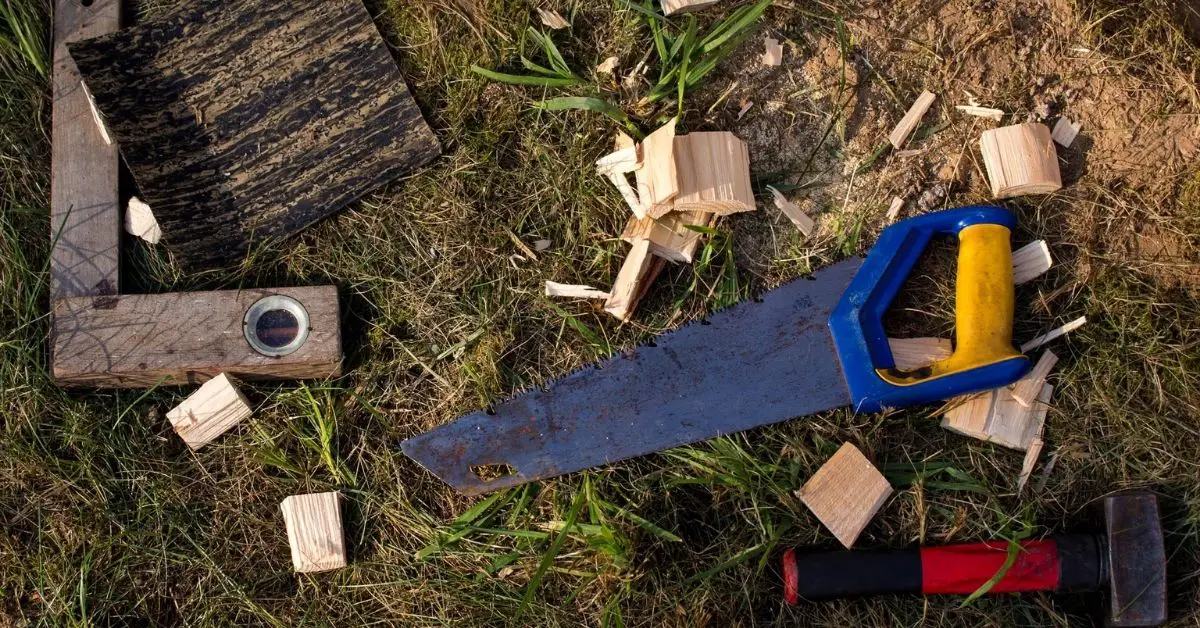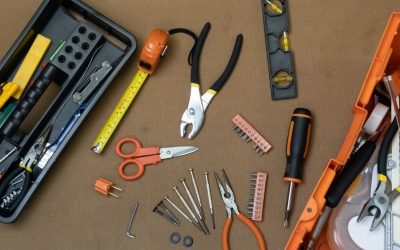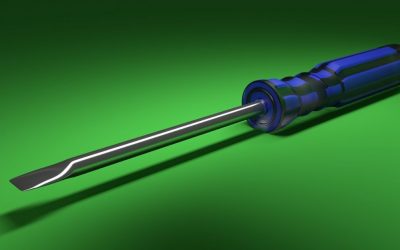Share

- What Is A Handsaw?
- Types Of Handsaw
- Tips For Choosing The Best Type Of Saw For Your Needs
- Safety Precautions When Using A Handsaw
- How Long Do Saw Blades Last?
- Sawing Through Metal With A Handsaw – Is This Possible?
- How To Shaper A Handsaw
Have you ever wondered what the differences are between types of handsaws? There are many different types to choose from, but not all saws will work for your project. This blog post will discuss the different types of saws and which one suits your needs.
What Is A Handsaw?
A handsaw is a tool used to cut wood and other materials. These tools vary in size, type of blade used, and design depending on the material they are meant to cut as well as the user’s preference for ease of use or accuracy.
Handsaws can be made with either metal or wood for their frame and handle (or grip) and can be found with either a straight or curved blade.
They also vary in the teeth on their blades, which are used to cut through materials such as wood and drywall. Handsaws may have raker teeth (teeth that reduce tear-out of material) or gullet sized for different types of workpieces and materials being cut.
A handsaw is typically held by its handle but it may also be attached to a power tool such as a circular saw so that it can be pulled along rather than pushed forward during use.
Types Of Handsaw
There are many different types of saws, each with its own unique use. Whether you’re a novice or experienced woodworker, knowing the best type of handsaw to choose will save time and help get your project done quickly.
Hack Saw
This saw has a very thin blade. Its handle is smaller than the blade itself. The thinness of its blade makes it a great saw for cutting metal and other hard materials while being able to achieve precise cuts.
Uses Of Hack Saw
Hack saw can be used to cut steel and iron, because of its thin blade. Moreover, its small handle allows for better control.
Coping Saw
A coping saw is a type of handsaw with a very thin blade designed to make precise, curved cuts in wood or other material. It has two handles at right angles to one another, which are used by pulling the saw toward you and pushing it away from you as if using an angled hand-saw.
The blades come in many shapes and sizes but most have between ten teeth per inch (TPI) on their rip-cut side down to twenty TPI on the cross-cut side. A coping saw can typically be held with one hand while cutting, freeing up your second hand for holding onto materials being worked on.
Uses Of Coping Saw
Woodworkers use coping saw to cut plastic, fiberglass, or metal. It can also be used for cutting holes into wood. The thin blade of the coping saw allows you to make small curved cuts that would not be possible with other types of handsaws.
Keyhole Saw
A keyhole saw is a type of handsaw designed for cutting holes in doors or drywall. It has either an extra-fine blade (less than 14 teeth per inch), making the cuts easier, but also reduces the stability while you are cutting; or a normal coarse blade (more than 16 TPI), which makes them less likely to break when pushing against hard materials like wood. Typical keyhole saw blades range from seven inches long up to ten inches.
Uses Of Keyhole Saw
Keyhole saw are used for cutting holes into doors, drywall, or wood. It has a very different design that allows it to slip into small areas.
Folding Hand Saw
A folding hand saw is a type of handsaw where the handle folds over the blade(s) when not in use, allowing it to be carried easily without damaging either the edge of the blade or your belongings.
A folding hand saw can carry several blades at once. The most common sizes range from eighteen inches up to twenty-four inches long, although they may also come as short as twelve inches and as long as thirty-six.
Uses Of Folding Hand Saw
A folding handsaw is best to use when you need something compact. It is also good for carrying around since it can carry several blades at once. Its blades are not that sharp compared to other saws, but this makes them more durable.
Crosscut or Ripcut Saw
Crosscut saw is a type of handsaw where the teeth are angled across the blade, while a rip cut saw has them pointing in line with it. Depending on how you use these types of saws will determine if they should be crosscutting or ripping.
The larger and thicker your material, the more likely it that you need to choose cross-cut over rips. However, either one can get the job done just fine for small projects such as cutting plywood.
Uses Of Cross Cut Or Rip Cuts Saws
Both types of cuts have their own unique uses depending on what project needs to be done. If you’re looking to do some heavy-duty work then go with crosscuts but if you’re cutting plywood or doing some fine work, go with rip cut.
Cross-cut saw blades are much thicker than rips, this makes them more durable to use on heavy-duty jobs. It can be used for both crosscutting and ripping, depending on what you plan to do.
Japanese Saw
Japanese saw is a type of handsaw where the blade can be pulled or pushed. Unlike other types of hand saws that you push and pull, this one has a smoother cutting motion as it glides across your material.
It also allows for more control since you don’t need to apply as much pressure on the tool while doing so.
Uses Of Japanese Saw
This type of handsaw works well with materials such as plywood since its blades are not that sharp, allowing them to cut through easily.
This makes it easy to use when working on small projects such as woodworking or constructing items out of fiberglass. Its smooth cutting motion helps prevent accidents from happening during usage.
Bone Saw
A bone saw is a type of handsaw that has an extremely coarse blade with tiny teeth. It’s used in the medical field to cut through soft tissue, hard materials, and even bones. This tool does not have any grip attached, so you need to be very careful while using this one since there are no handholds for extra support.
Uses Of Bone Saw
Bone saw falls under the category where they are most commonly found in use by surgeons or paramedics but can also be found being used when hunting large game such as deer.
Its sharp blades will easily puncture the skin, allowing quick clean cuts, making them perfect for hunters who like cooking their meat onsite or those located in deep forests far away from hospitals and medical centers.
Pruning Saw
A pruning saw is a type of handsaw that has a blade with many fine teeth. It’s used for cutting through branches and stems, this makes it very useful when you’re trying to shape trees or simply cut them down.
The thin blades allow easy access into tight areas such as tree branches which are always curved in some way at the ends making it difficult for other types of saws to puncture easily.
Uses Of Pruning Saw
Pruning saws are most commonly used to achieve a finer cut when pruning trees or bushes, they can also be useful for cutting vines. For heavier branches, you may need both hands to help push through with more force, but it is always advisable not to strain yourself too much as this saw tends to require some effort.
Panel Saw
A panel saw is a type of handsaw that has a long, sharp, and flexible steel blade. It’s used for cutting panels such as veneer or plywood along with plastic laminates and sheet materials like MDF (medium-density fibreboard). The longer the length of the blade makes it great for achieving straight cuts but because it can be quite unwieldy there needs to be plenty of space around you before starting any works.
This particular type of hand-saw also gives you more control than others, allowing you to take your time while working on objects such as furniture pieces if they need fixing or replacing parts.
Making fine adjustments within tight areas can be difficult with this saw, but because of the blade’s flexibility, it will cut into corners without having to turn the tool round.
Uses Of Panel Saw
There are many uses for a panel saw, especially within carpentry and construction where cutting panels is needed on site.
This particular type of hand-saw also gives you more control than others, allowing you to take your time while working on objects such as furniture pieces if they need fixing or replacing parts.
If you’re looking at creating patterns then this saw will be best suited due to its thin blade which will give your work a much neater finish. Because the teeth are so fine there isn’t any roughness that could otherwise occur when using other handsaws meaning materials won’t be damaged as easily.
Fret Saw
A fret saw is a type of handsaw that has an extremely thin metal blade with fine teeth. It’s commonly used to make intricate cuts in pieces that are too small to be cut using other tools.
Uses Of Fret Saw
Fret saws tend to be the most difficult type of hand-saw to use because you need very steady hands and lots of patience when working on smaller objects.
The blades also tend to break easily if they get caught up and can snap under pressure, so safety should always come first before starting any works!
This particular type of hand-saw also gives you more control than others, allowing you to take your time while working on objects such as furniture pieces if need fixing or replacing parts.
Fine Saw
A fine saw is a type of handsaw that has very fine teeth. Its handle is usually made of wood, and the teeth are very small, giving it a smooth finish on the wood.
Uses Of Fine Saw
Fine saws are very useful for making fine detail cuts or where you need to get into tight corners. If you’re looking at creating patterns, this saw will be best suited due to its thin blade, giving your work a much neater finish. Fine saws can also be used when making joinery pieces.
Jab Saw
A jab saw is a type of handsaw with a short, flat blade with fine teeth handsaw with a small, narrow metal blade. It’s useful for cutting curves in wood or other material when precision is important.
Uses Of Jab Saw
Jab saws are very similar to coping saws, but the main difference between them is that you can’t change where your cut starts and ends with this particular type of hand-saw. This makes it ideal if accuracy isn’t an issue because once your jab saw hits its target it will continue through no matter what.
As well as being used for making curved cuts which would be difficult using larger handsaws, jabs also come in handy when creating dowel joints, especially within carpentry work like cabinets or chairs! The teeth on these types of hand-saw also tend to be thin and sharp which means that they will give you a much cleaner finish.
Drywall Saw
A drywall saw is a type of handsaw with a very thin, narrow blade that can be easily maneuvered into corners and tight spaces. It’s often used for cutting inside wall cavities or making detailed cuts to wood.
Uses Of Drywall Saw
Drywall saws are ideal if you need an extremely precise cut because their thin blade allows them to easily get into small areas.
If you’re looking at creating patterns, this saw will be best suited due to its sharp teeth and slim design, which gives your work a much neater finish than other types of hand-saw, especially when working on delicate objects such as furniture pieces!
The blades also tend to break easily if they get caught up and can snap under pressure, so safety should always come first before starting any works!
Bow Saw
A bow saw is a type of handsaw with teeth on one side of its blade. It’s used for making cuts across the wood, such as curves or notches.
Uses Of Bow Saw
Bow saws are perfect if you need to make deep curved cuts because the shape of their blades allows them to be drawn towards your body which means that they’re great at slicing through large pieces in good time.
These particular types of hand-saw also give you more control than others, allowing you to take your time while working on objects such as furniture pieces if they need fixing or replacing parts. However, it can be difficult when using these specific types of hand-saw around smaller areas so always keep safe no matter what!
Baseball Saw
A baseball saw is a type of handsaw with teeth that are shaped like a baseball diamond. It’s suitable for cutting curves in wood and other materials.
Uses Of Baseball Saw
Baseball saws are the ideal tool for creating a very smooth finish because of how their teeth have been designed, which allows them to cut through material with ease without damaging or splintering the edges!
The blades also tend to break easily and snap under pressure, so safety should always come first before starting any works!
This particular type of hand-saw is perfect when making joinery pieces within carpentry work like cabinets or chairs, especially around intricate areas such as legs where accuracy isn’t an issue!
Rip Saw
A rip saw is a type of handsaw with teeth that are close together and set to the right. It’s used for making straight cuts in wood or other materials.
Uses Of Rip Saw
Rip saws are perfect if you need accuracy when working on larger pieces because their design allows them to cut through solid objects quickly, easily, and smoothly! The blades also tend to break easily and snap under pressure, so safety should always come first before starting any works!
These particular types of hand-saw work best around areas where precision isn’t an issue like furniture pieces such as legs which don’t require complex curves or patterns, instead all they’ll need is basic joinery work!
Tips For Choosing The Best Type Of Saw For Your Needs
If you’re looking for a saw which will give you a perfect cut time after time, then you should choose based on the following considerations:
The Handle
The handle can affect your accuracy when sawing, which is why it is important to find the correct size for you. Moreover, a saw with a smooth, ergonomic handle will ensure that your hand is not tired even after long periods of use.
The Blade Length
Blade length affects the depth and width of cuts you can make as well as how stable the blade is while it’s moving over an object. In general, handsaws have blades that are between 18-32 inches in length.
The Blade Width
Blade width is measured from the edge of one tooth to another and affects how many cuts you can make with a single pass as well as your cutting speed. In general, handsaws have blades between two-thirds and three quarters of an inch wide.
The Teeth Per Inch (TPI)
The teeth per inch on a saw are an indication of how smooth the cut will be. The higher the TPI, the finer and smoother your final cut will look compared to using a lower TPI blade. If you’re looking for something that makes fine cuts, choose one with either 24 or 32 TPI; if you need faster-cutting speed, opt for blades with 18-20 TPIs instead.
The Material
The material which the saw is made from influences many things about it; most importantly, how long it will last. For example, plastic handles are lightweight but can damage easily during use. Sturdier options like high-carbon steel and cast iron may be heavier but provide you with more stability when cutting as well as being less likely to bend or warp over time.
Sawing Accuracy
When choosing your type of handsaw, consider whether accuracy is important for the work that you’ll be doing with it. If so, then invest in a saw with excellent precision capabilities!
Safety Precautions When Using A Handsaw
- When using a handsaw, there are a number of precautions that should be taken in order to avoid injury. These include:
- When cutting, cut with the grain rather than against it;
- Do not force a saw through wood and do not use for purposes other than what they are designed for; and
- Make sure there is proper support behind whatever you’re trying to cut.
If you follow these procedures when using your handsaw then injuries will likely be avoided or at least minimized if an accident does occur.
If you’ve never used handsaws before seeking assistance from someone familiar with their use until such time as you gain adequate experience on your own behalf. Handsaws can easily slip while being used, resulting in serious cuts, so make certain to keep them out of reach of children.
How Long Do Saw Blades Last?
If you maintain your handsaws, they will typically give a lifetime of use. Properly caring for them involves keeping the teeth sharp and cleaning any debris from the blade after each use to prolong their life even further. The exact amount of time that a saw can be used depends on what it’s being used for as well as how well it is maintained during its lifespan.
Sawing Through Metal With A Handsaw – Is This Possible?
Saws are designed specifically to cut through wood and make cuts in other materials such as metals that aren’t too thick or difficult to navigate around curves or corners when doing so. However, because there isn’t much room between the teeth on a handsaw it can be difficult to cut through thicker metal objects with them. This is why a hacksaw or tin snips are usually used for these kinds of tasks instead.
How To Shaper A Handsaw
Sharpening your saw is an easy task which you can complete at home. Here are the steps for how to shape a handsaw:
Step One
Take your saw to an area where you can lay it down flat. Use the file to remove any major nicks or dings in the blade and then use fine-grit sandpaper for smoothing out these areas further if needed.
Step Two
Next, move on to sharpening each tooth by filing them one at a time with light pressure so that they are all evenly shaped afterward. If your teeth aren’t properly aligned after this step, return for additional filing work until they are perfect once again!
Step Three
You’re almost finished now, next thing is to clean up the metal of the blade carefully before oiling each side of it thoroughly with a small amount of machine oil applied with a cloth rag which absorbs most of the excess. Allow it to sit for about five minutes before wiping off the excess oil and placing your saw in a location that is out of reach from children.
There are many types of saws, but the most important thing is to choose one that meets your needs, fits your budget, and provides you with a proper amount of safety when using it. When maintaining them over time, they will provide years of use, making all kinds of cuts for more efficient home projects!



0 Comments